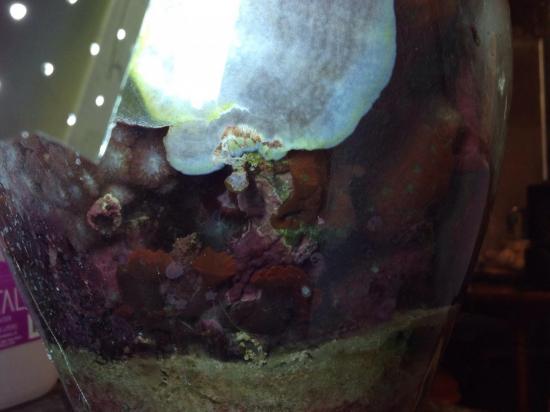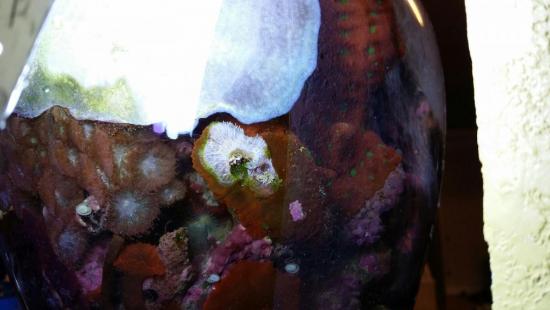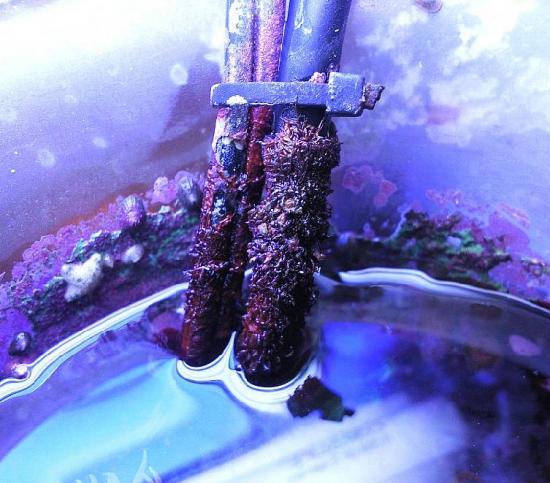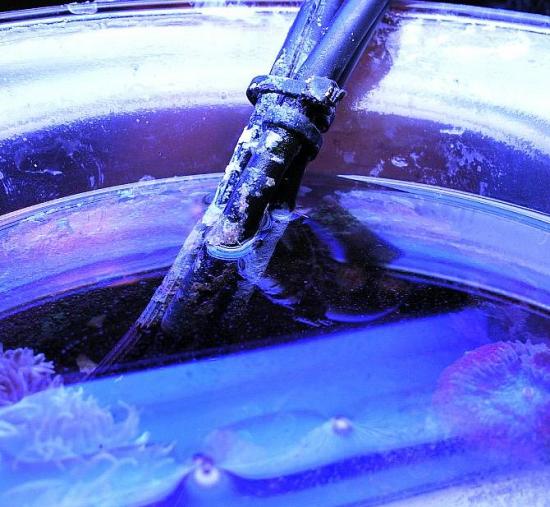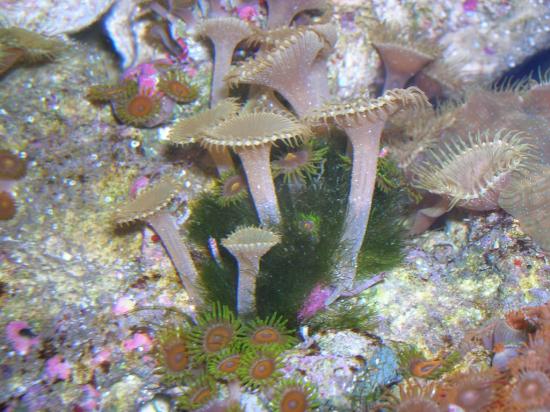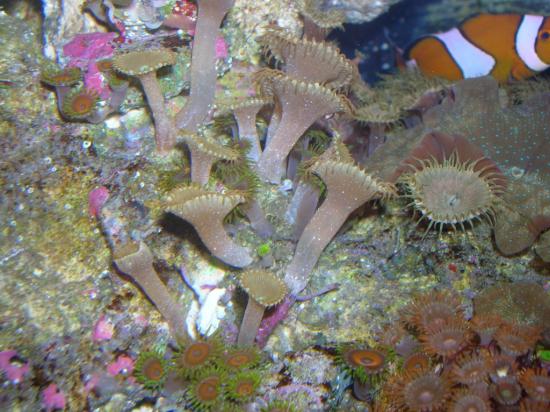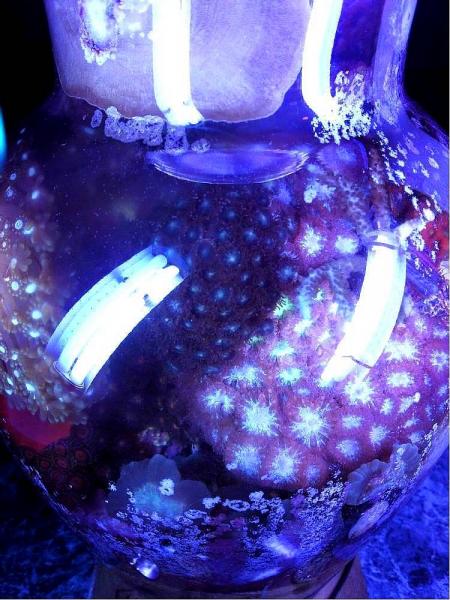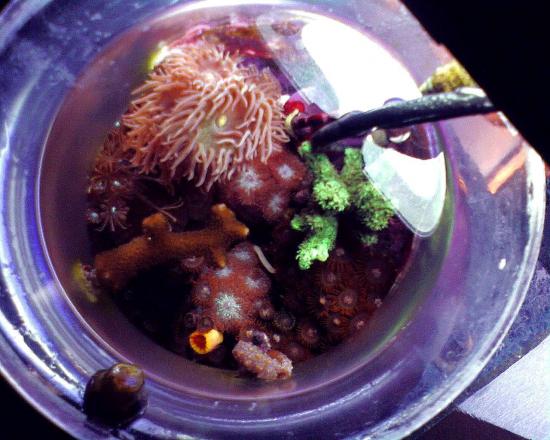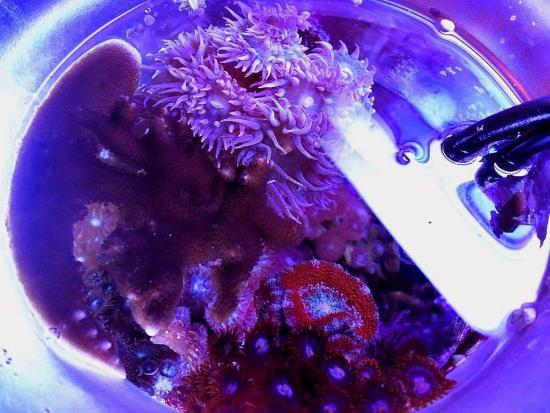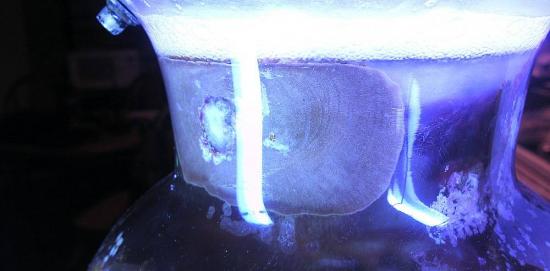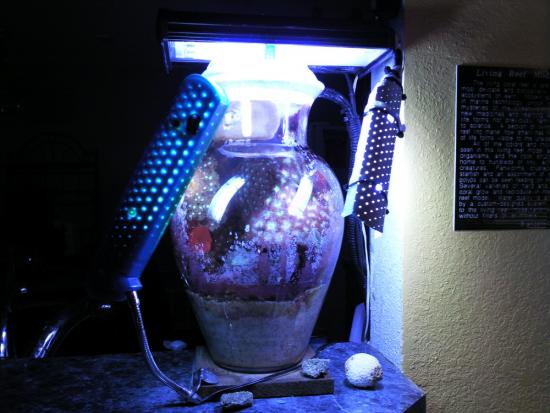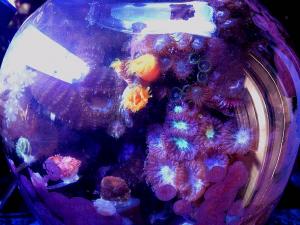-
Posts
63 -
Joined
-
Last visited
-
Days Won
1
Content Type
Profiles
Forums
Gallery
Everything posted by brandonm
-
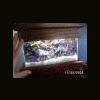
8 year old 1 gallon reef, 12 yr old planted sphere (19")
brandonm replied to brandonm's topic in Members Tank & Specs
The pic above is February this is just now blue sps grows unchecked at a rate of 3/4 inch every 3 mos, real estate is limited in the ten pound reef I'm concerned though, it's obstructing my glass I'll have to laser kill portions of it soon Also see the red brain growth here vs above, its taken over that bottom lip on the lower rock now. Its the fastest growing LPS Ive ever seen in my bowl Here is before the spread of the blue sps The lights are cheaper power compacts from twelve yrs ago but bulbs are kept up Ran by airstone only, dosed with two part c balance but it grows coral well because of the feeding technique that allows so much feed input. The age of the system plays an additional role in self support, as gametes and various organisms populate the water and comprise mini food webs corals can utilize. Old reefs have specific details that younger reef tanks do not have, its evident in areas of calcification and details on the live rock that reflect a sustained ideal feeding and light intensity environment. -
The age old battle: legitimacy, natural vs unnatural None of that applies here, we are for the desperate or the prevention of the desperate any other method should be considered first if you wrestle with natural vs unnatural methods, whats acceptable and not acceptable to use. All we do is fix tanks, period sometimes peroxide threads come down to this: bandaid we talk about that too in the thread. there is a reason the thread keeps getting used by scores of people even though I dont post in it anymore, outcome. maybe something better will come along and this will stop being used, but I dont think so its good to detract anything and see if it stands a test. pick any one of our cure tanks you'd have fixed a different way, and lets discuss and make predictions about how that w go down this is always good science discussion material In time I noticed that nobody can tell you to use peroxide, or ATS Santa Monica methods, or GFO, or refugiums, or DSB's, or UNLS systems as a "best" way as long as successful tanks using all these methods exist, all that means is you have a salad bar choice on how to beat your algae problems. Each has pros and cons, a blend of one or more methods is often powerful the fact is peroxide works, long term, and we can control and predict what it does, its not haphazard. its limitations and benefits are outlined, see if your problem tank can beat my challenge. at the end of the 4 years, I call 90% fixed.
-
Try to find time to read the thread where you can see all the pics in it, nearly all questions are answered in those pages, and tanks of many kinds are shown. surely one will approximate any tank we need to review in here as well. This method is powerful. Here are highlights of a 60 page thread showing various cures we can discuss here, I dont post at rc anymore: -the most susceptible animal in a reef tank to peroxide is lysmata cleaner shrimp -nearly everything else is tolerant in some way we have shown in the thread, with outcome pics the *most* tolerant organisms in our reef tanks of peroxide is actually the filter bacteria, as indicated by myriad ammonia testing done in these aquaria. Almost no usable concentration of peroxide has been shown to affect filter bacteria, cause mini cycles etc, and thats assumed to be the greatest risk of in tank use, we show otherwise. -known timeframes you can expect certain organisms to die off in, to see if this method is working -ways to treat full running mixed reefs, or sections that are simply lifted out and treated and then rinsed we talk a -lot- about the physiology of algae invasions in this thread, but even better we establish repeatability and predictability for peroxide use in the reef aquarium, check it out if you are having problems other methods seem to ignore
-
Everyone has an idea on how to fight algae and various invaders in a reef tank, here's mine its 4 years worth of before and after pics, tanks ranging 1 gallon to 400 gallons all kinds of setups using the same treatment method, peroxide. Its one tool of many to use in our tanks, per this thread, we wield it like Thor's hammer: http://www.reefcentral.com/forums/showthread.php?t=2082359 try anything else first for your green hair algae, red brush algae, dinos, and then try this
-
what meaty foods are you feeding the tubastrea (mysis, cyclopeeze etc) phyto isn't enough for long term mass retention on those big azoox colonies, they need meat
-

8 year old 1 gallon reef, 12 yr old planted sphere (19")
brandonm replied to brandonm's topic in Members Tank & Specs
in this picture, you can see extreme sps and lps growth approaching a battle, the blue sps can beat the red brain, I would have thought the brain would win. 6 month update from my last post, the vase is going strong The reefbowl is the longest running pico reef on the planet, none have been running longer. if you can find one, please post the vid or the pics we need their data to reference in longevity studies for small reef aquaria for a new article Im doing -

8 year old 1 gallon reef, 12 yr old planted sphere (19")
brandonm replied to brandonm's topic in Members Tank & Specs
Just to toss in another vid, this is every pico reef I've built and aged with online friends and local friends -

8 year old 1 gallon reef, 12 yr old planted sphere (19")
brandonm replied to brandonm's topic in Members Tank & Specs
http://www.nanoreefblog.com/features/pico-reefs/the-history-of-pico-reef-biology -

8 year old 1 gallon reef, 12 yr old planted sphere (19")
brandonm replied to brandonm's topic in Members Tank & Specs
Hi! I'd like to clarify the keeping so it doesn't look like hocus pocus lol This is a simple pico reef method to run any small reef under 3 gallons regardless of the shape of the container We know coral has to feed, the key is I only feed high quality reef food weekly, before a large water change. I dose two part into the lid so it gets in the tank to keep calcium and alk up. Now where this vase smashes any other tank, including 200 gallon ones, is freshwater evaporation loss. My tank does not need auto topoff. You can add one ounce of distilled water a week as topoff, this is dedicated evaporation restriction science I restrict eevapration, so there is less freshwater loss and better salinity control than really any tank out there which relies on surface area exposure and mass evaporation for cooling. This is opposite, and more stable. This gallon reef is an indefinite lifespan ecosystem and is a test run in longevity. The addition of 35% peroxide in a very careful method is critical to making it run this long. If you have an hour to kill, this article details the history of small reef biology. I believe the reefbowl and online documentation of it to be the first video posted on the Internet of a one gallon reef with grown in stony corals. Use the entire Internet to find a picture of a one gallon reef before 2001 and post back if you can find one, that would be a necessary mention in the history of pico reef biology I have seen some online using tidal rocks placed in a jar from the 70s... But I mean a captive ecosystem raised and grown/cemented in place years established using stony corals and synthetic salt water, I'm looking for any documentation we can find to include. Here is an article on introduction to non evaporating, and partially evaporating reef aquaria. I am certain that the sealed micro reef is the first of its kind across marine science. ..thanks for stopping by! -
No big deal you are almost to 100. What happens at 100th post here?
-
If you walked into a store, and told twenty women they looked nice all at once where each could hear you say it to the next, would they believe you? I realize you are trying to reach a certain post count now. That's why it looks insincere
-
Nicky, why have you written nice tank on all twenty threads in the nanos forum over a span of five minutes I've never seen that done before. It doesn't look sincere.
-
Thanks for stopping in Admiraltian Soon I hope to get LEDs, the coloration is really behind the times...might hang a par 30 from a ceiling pole mount
-
I think this is the last tank still using pc lighting from 10 yrs ago lol super old pico reefs do things very differently than what is common for smaller tanks. smaller tanks tend to be ran lilke larger ones, so they dont last long....
-
Still running, we know how to make pico reefs last forever now no algae, etc if you are having any problems getting your pico out past a couple years, post and we'll fix it
-
Zac nice to meet you I can tell you've been online for awhile, not alot of 2004 logins around. What a great forum, the pics and information are top notch.
-
I am interested in those toads too I owned one for a long time in my planted bog~
-
I found out last year that pico reef work has been located all the way back to victorian times of the 1800's! http://www.parlouraquariums.org.uk/Papers/b%20AQUARIUM%20HISTORY/History%20Papers/Parlour%20aquarum.htm
-
challenges with long term pico reef care: -one challenge in running a pico reef long term is to keep stocking animals vs letting the ones you have grow into position. Slow additions to a pico reef and corals that take on biomass themselves work hand in hand to downregulate the chemicals corals use to make warfare. its better to age your tank and let it pack, vs pack it up front and hope it ages. -sps color retention is very very challenging. Im running some blue sps now for a few months that is doing well, but the darkening of sps has been shown to correlate with higher nutrient indexes + lighting challenges created as corals shade each other and systems age all this is the next generation of pico reef work, ULNS work and dose specific colorations are two SPS fronts slowly taking shape in the world of pico reef care and design. Hope this helps spur some thought with your tanks B
-
before and after fire burning in the vid on red brush algae before and after peroxide treatment on green hair algae, posted by my friend .Newman: using abiotic methods to control algae and pests makes them come back less often, not more often. We have been incorrectly told that stripping the water of nutrients (phosphate and nitrate) is the only way to stop algae. Maybe if I can keep the bowl going into the next decade some of the professional writers might agree to look into rule bending and what that means for reef tank care as a whole. I do hardly any algae work on my bowl, but its supposed to be wrecked with algae because I have measurable phosphates etc...
-
I would also like to mention the way we are cycling the new pico reef is a significant cause of problems, old tank syndrome, late in the life of the tank if it makes it that far without hardware failure. We are told to follow a hands off approach in fear of upsetting some balance in the pico reef (usually its bacteria we fear upsetting) and we are told that alternating generations of algae and diatoms are normal and you just wait until they subside, and are either replaced with another generation or a clean tank, whatever the odds throw at you. I have seen this to be patently wrong in practice. Allowing generations of algae and diatoms to inhabit your tiny pico at any time allows for biomass of that organism to take up residence either in active or potentiated forms, such that the slightest nutrient imbalance after month 15 starts to grow more algae than you ever were ready to deal with. Diatoms themselves, the general term we use to describe the brown haze that shows up on the rocks of new pico reefs, isn't exactly harmful per se but they often show up bound with other forms of algae within the floc/biomass/biofilming and its this combo intruder that has the chance to throw string diatoms at you, cyano bacteria, and the common forms of green hair algae we all despise. Concomitant sporulation of algaes together is a problem not often predicted by those relying on the hands off/it'll cycle itself admonition from those who specialize in large tank care. If you simply remove all algae, the instant you see it, with one of the proven abiotic methods, no invasive pest can ever take over your tank. Fire can be used in place of peroxide, I have fire burned every known pest you can list. I do this by draining my tank water down and burning the offending pest directly, then filling up the water. No poisons are created, that was a false assumption made by many in the online forums: The point is when you see red turf algae, or green hair algae, or any of the invasive macro algaes like valonia/bryopsis, you don't add an animal to fix it, you fix it yourself free of charge and without increasing the bioloading of the tank that is causing the initial problem. Peroxide shows an amazing effect whereby algaes that are consistently treated simply stop coming back to the tank even under the same water params that may have caused the first bloom. We were always told you have to eradicate the source to stop the algae, not true. As long as water params are within coral growth zones, algae can be eliminated abiotically (without animals or natural methods) and it can be eradicated without considering water param measures like nitrate and phosphate. There is nothing wrong with using nitrate or phoshpate consuming media or tank designs (ATS scrubbers) but this is just an alternate method to attain a perfectly algae free tank for the complete duration of any pico reef
-
Hello team and friends I logged back in to post an update to this vase, the same vase is now approaching 65+ months and it is very helpful to take some of the activities Im using to run this bowl for so long and incorporate them into your pico reefs if they need tuning. The major things Im doing to get an indefinate, algae free lifespan for this bowl: -big water changes. small partial water changes, like the rules we used to follow with larger tanks, is killing pico reefs slowly around the globe. They run for a year at best, then start to take on algae and animal death/coral growth slows and then stops -using peroxide, hydrogen peroxide, as an immediate treatment for algae when it does pop up. The use of peroxide as spot treatments in the nano reef is the single best killer of algae Ive ever seen, its preferable to chasing perfect water params to try and starve it. We are being advised to treat algae in the nano reef incorrectly. Its not about clean up crews and perfect water params, peroxide is truly amazing and a cheat that can't be underestimated. There is no need to test nitrate and phosphate in my pico reefs, because algae cannot grow when it is treated with peroxide. The method of peroxide killing is very specific, you don't dump it in the tank. ask if you want to know, or if you have problem algae you can't beat even with good water params. By using peroxide, I do less work on my tank for algae than any other pico reef 1/4th as old. peroxide is the best thing I have ever come across in a decade of pico reef work -dosing the tank with c balance two part solution. Without adding a two part solution, my water changes would be so constant it wouldn't be worth it. C balance calcium and alk allows me to get the longest period in between water changes I can get (one week, two max if on a vacation where I have someone come dose the tank) the method for dosing a pico reef is nothing like adding two part to a larger tank. I feel it is not possible to keep a gallon reef alive past 3 years without dosing, they are opposite than larger reefs in ion consumption, tiny reefs that are aged need more dosing, not less, as we've been told by people who have no experience with aged pico reefs of a small size -feeding the tank only when a water change is planned. Pico reefs tend to be cared for like miniature large tanks, and this is another reason they die before three years commonly. When you feed a tiny pico reef everyday, you sink waste into the rock surfaces and the sandbed and then as it reaches a setpoint all that waste starts to come back out. Usually by the 15th month... instead, if you will stock lightly or none on the fishes that require daily feeding, a huge coral load and a loading of inverts like I keep in my reefbowl will acclimate to bi weekly or weekly feeding without a problem and this is better for your tank because it stores up less accumulative nutrient. Rather than feed lightly each day which underfeeds the animals and creates waste buildup, I wait until water change time and feed the tank 10x the normal amount of feed, enough for a 75 gallon tank. thats right, I feed my one gallon pico the amount of cyclopeeze you'd put in a 75 gallon tank. the trick is, I only let it swirl for an hour than I change out all the water, leaving only fattened polyps and amphipods full of feed instead of barely fed. unused feed is ripped out, it doesn't penetrate into the bed. Whats in the sand bed is the usual detritus in the process of degrading, but the amount of waste in the bed is greatly reduced due to the feed timing. the result is a mega clean reef considering the age, all original sand and rock and corals, zero invasive algae at any time in the life of the tank (day 1 until now, no algae is part of a cycle thats wrong too) and animals that are so numerous I would estimate there are more than 10,000 life forms able to be seen with the naked eye in this vase. This vase is the oldest pico reef in the world (longest running original setup no teardown) and its a model to show a way of reversing the usual rules of pico reef care to make your tanks live as long or longer. Across the internet, here are the max lifespans per gallon of water in even the best cared pico reefs, this is helpful to know: 1 gallon and less- 8 mos max lifespan using the common care recommendations 2-3 gallons -2 yrs at best, with the longest Ive ever seen at 3 years documented (El Fab's reef at nano reef.com) a keeper on reefcentral said she had a 3 gallon for 8 years but there is no thread documentation or pics. We only go off pics and vid, not stated ages because I don't believe them. 4-5 gallon same lifespan as the 2's and 3's, but tanks attaining the 3 year mark are becoming more common. in my next post I will link an update vid and pics for my vase as of this week Brandon see ya'll in 2012 for the 75 month update lol
-
I am posting up my response to a pm sent to me because I think the system is not replying because of some technical thing. This was a pertinent subject so to get it to oddball and anyone else I'll just make it a public comment: Hi oddball thanks for asking Id love to chat. Luckily the system notified me of your message, if that ever doesn't work just hit me up on comments. Regarding the UGF being a nitrate factory, they can, but there are also measures of control if you are determined to keep one. Why have one? they can help expose wastes to more active surface area, you know by drawing water through the substrate than just passively around it. This is only needed if you are registering ammonia, after cycling, when the tank shouldn't show ammonia it means your bioload is exceeding your surface area, so any additions- be they UGF, mechanical filter etc will reduce ammonia by using more surface area + oxygenation to convert that ammonia. So UGF's work the same as any filter that traps waste, that's where the factory issue comes in. It's hard to vacuum up under the grating, and this continual degredation of detritus yields a constant pump of nitrate, but then again so does any filter that traps particles for filtration. It's just canisters are easier to clean! So, the firm rule of all aquaria, not just nano reefs, is you already know exactly how much filtration is needed without a guess. If, after a good cycle, your feeding regimen or stocking of animals -ever- yields measurable ammonia you need more surface area from one of any common means including UGF. If you have never registered ammonia after cycling or a good heavy feeding, no extra filtration is needed and in fact any extra filtration becomes a nitrate trap if you don't clean them a lot. Lastly, some people choose to use filtration to clean the water of suspended particles, not just for ammonification. Based on this paragraph, I hope it will let you choose your filtration as needed without trapping too much waste. You know I wasn't including a skimmer in this analogy since it actually removes, exports wastes unlike trap filters. The mantis' are exquisitely sensitive to ammonia I would be interested to know if you ever measured any recently. Sometimes a large feeding, coupled with their nitrogenous waste thereafter, can briefly overwhelm your surface areas with a small burst of ammonia generated, this is just a guess. Youd have to test the setup again with another mantis I really can't guess what it would be one-off because poor genetics of the animal or simple disease can't be ruled out. The algae is a common life form in cycling tanks, but I am sure you do not have to let it bloom in order to cycle. Better to never have it, or you may end up battling it! It's easier to avoid algae in a tiny pico cuz you can just change water more often than a larger tank, so I never let it bloom. The first time I see a sprig of algae, I *permanently alter my water change by adding an extra one each week, which keeps algae gone forever. In tanks where algae catch a footing due to lack of water changes, you can have algae for weeks and weeks even after you fix your nutrient issues because all plants can live on their own internal stores for quite some time. That's why any old Joe can go buy a water plant, go home and put it in a vase and not care for it and it will live a month still, it's just existing on internal stores, and algae will do the same and trick you into thinking your tank is still producing it when in fact the water may be clean enough now to have never sprouted it!!! Watch out for that phenomena in algae control. Stay in touch sorry I couldn't be more specific but altering these variables I mentioned above will give you a more controlled start for next round of tank experimentation. Try to remove all the algae you can manually, burn some of it off with a jet flame cig lighter by draining the tank for a water change if you can, this works great! You need to change water more often now, matter of fact get your nitrates double checked by someone else to ensure kit validation, and always keep it below 10 ideally 5 or less. Some wouldn't recommend you work to keep them that low, but I always have so it's all I know. I didn't see a phosphate reading, but it's usually closely coupled to nitrate anyway (both coming from tank feeding) and DNA is actually made fundamentally from both elements (N and P) so it's neat to see that anywhere you have life, you have detritus, ammonia, nitrate and phosphate if the degredation teams are working correctly. You can skim more, vacuum better (which may mean removing that UGF if you aren't willing to undergo far more water changes, say 80% weekly until your problems subside. Im afraid at your current rate the system will become algae dominant so this is my prescription lol B
-
sent ya a pm~ also crew if youd like to read an article I wrote about the vase and about pico reef history (2.5 gallon tanks back into the 70's) its here http://www.nanoreefblog.com/features/pico-...co-reef-biology


